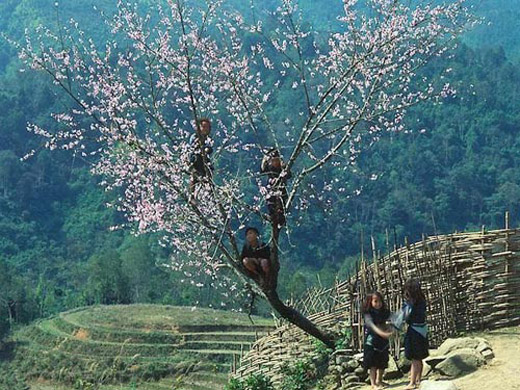"The breathtaking scenery of immense terraced fields is reward enough for those long trips," said the engineer.

For three years, Nguyen Trung Dung has never missed an opportunity to admire the
terraced fields in Mu Cang Chai (Yen Bai Province) and
Hoang Su Phi (Ha Giang
Province) during the harvest season in September. To enrich his photo
collection, he happily travels nearly 2,000km from
HCM City to the northern
region.
"The breathtaking scenery of immense terraced fields is reward enough for those
long trips," said the engineer, 50, who proudly shares his collection of
thousands of photos of northern mountainous regions with his friends on Facebook.
The magnificent terraced rice fields of ethnic minority tribes, with yellow
ripened paddy grains and seemingly endless stretches of flowers, have transfixed
viewers for generations.
The terraced fields appeared in Mu Cang Chai and Hoang Su Phi several centuries
ago. Even before being recognised as national tourist attractions by the
Ministry of Culture, Sports and Tourism some years ago, they had already become
hugely popular destinations with local adventurers as well as foreign travellers.
Ha Giang is famous in September for its yellow terraced fields, but in October,
the province is best known for pink Tam Giac Mach ("triangle oat") flower
fields.
Local residents say that once upon a time, the inhabitants of northern
mountainous areas mainly lived on corn and rice. One day, all corn and rice in
the house were nearly exhausted, but the fields could not be harvested. The
villagers were very hungry. Suddenly, they smelt a scent in the wind. They went
along the ravine and found a field of tiny wild flowers with triangle-shaped
leaves.
The villagers brought the seeds of the flowers home to use in place of corn and
rice and called them Tam Giac Mach.
Since then, the ingredient has been used to make bread or mixed with corn to
make delicious local wine.
There are other places to contemplate Tam Giac Mach flowers such as Bat Xat and
Muong Khuong districts in Lao Cai province, and Tra Linh and Trung Khanh
districts in Cao Bang Province.
However, the most popular destination is Ha Giang Province – specifically Sung
La, Lung Cu and Xin Man districts, familiar names to many travellers.
The flower blooms in late October or early November depending on the cultivating
time. Tam giac mach flowers often have three colours: light pink, glistening
purple and dark red. In the bright sunshine, it looks like a watercolour
painting. Its wild and endless beauty has seduced many romantic people.
"It's magical to see the slopes and valleys of Ha Giang turn red," said teacher
Van Nhung, 25. "The feeling of being immersed in a sea of flowers is stunning."
Flower travelling and photographing has become a popular pursuit among young
people. Besides Ha Giang, many other mountainous regions in the North attract
romantic hearts with their flowers.
In spring, people often flock to
Mount Fansipan in Lao Cai province to see
poinsettia blossoms.
Moc Chau Plateau in Son La province draws visitors in November with endless
fields of cabbage flowers, mustard green flowers and poinsettias. In spring,
apricot and plum blossoms cover the plateau in white.
Flower travelling is growing so popular that tour companies now offer
inexpensive seasonal "flower tours".
Tour operator Tran Ngoc Van said such trips are targeted at young people,
especially those passionate about photography.
The mustard green flower and tam giac mach season in the Northwest region
coincides with the wedding season in October and November, so this tour attracts
many couples, she said.
The dream-like yellow mustard flower fields provides great scenery for the
wedding photos of any young couple.
Seen from afar, the flower fields are like white clouds floating, making
visitors appear to be walking in a sea of clouds.
Read More:


